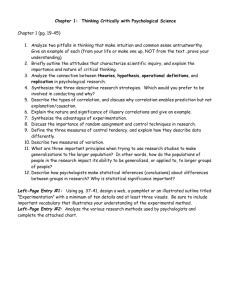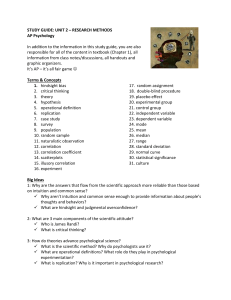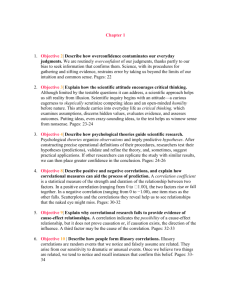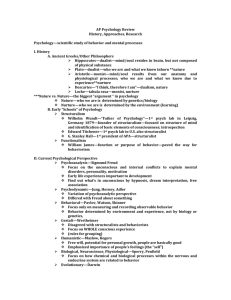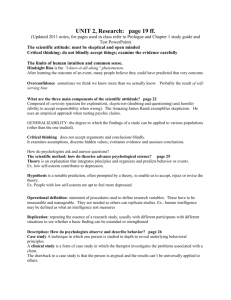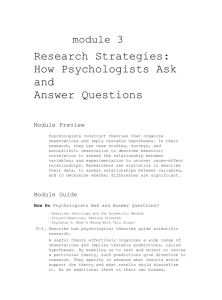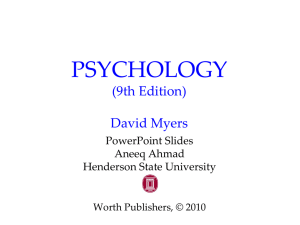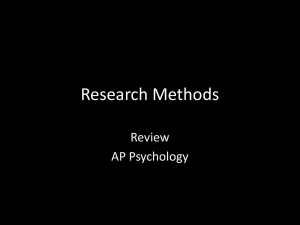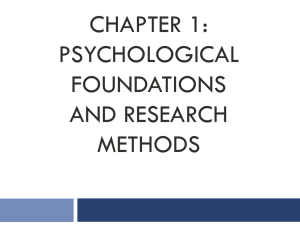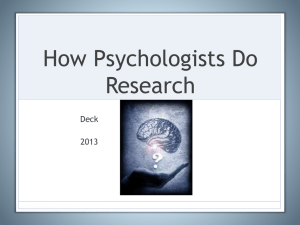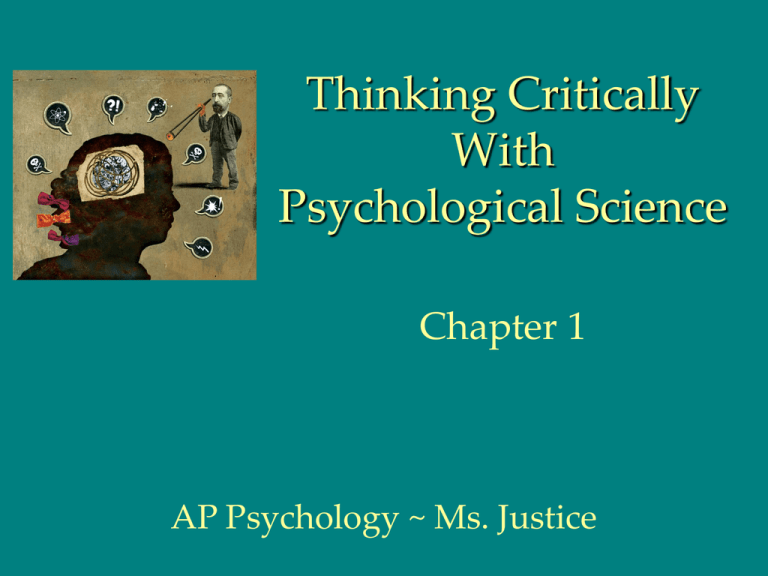
Thinking Critically
With
Psychological Science
Chapter 1
AP Psychology ~ Ms. Justice
The Monty Hall Problem: Common Sense or Statistics?
BIG IDEAS
The Need for Psychological Science
1: Why are the answers that flow from the scientific approach more
reliable than those based on intuition and common sense?
2: What are 3 main components of the scientific attitude?
How Do Psychologists Ask and Answer Questions?
3: How do theories advance psychological science?
4: How do psychologists observe and describe behavior?
5: What are positive and negative correlations, and why do they enable
prediction but not cause-effect explanation?
6: What are illusory correlations?
7: How do experiments, powered by random assignment, clarify cause
and effect?
BIG IDEAS
Statistical Reasoning in Everyday Life
8: How can we describe data with measures of central tendency and
variation?
9: What principles can guide our making generalizations from samples and
deciding whether differences are significant?
Frequently Asked Questions About Psychology
10: Can laboratory experiments illuminate everyday life?
11: Does behavior depend on one’s culture and gender?
12: Why do psychologists study animals, and is it ethical to experiment on
animals?
13: Is it ethical to experiment on people?
14: Is psychology free of value judgments?
1: Why are the answers that flow
from the scientific approach
more reliable than those based
on intuition and common sense?
Many people believe that intuition and common
sense are enough to bring forth answers regarding
human nature.
Intuition and common sense may aid queries,
but they are not free of error.
Because of hindsight bias
and judgmental
overconfidence, we cannot
rely solely on intuition and
common sense.
Hindsight Bias:
the “I-knew-it-all-along”
phenomenon.
After learning the outcome of an
event, many people believe they could
have predicted that very outcome.
Common sense more easily describes
what has happened than what will
happen.
Overconfidence:
Sometimes we think we know more
than we actually know.
Anagrams
How long do you think it would
take to unscramble these anagrams?
WREAT
ETYRN
.
WATER
.
.ENTRY
.
GRABE
.BARGE
People said it would take about 10 seconds, yet on
average they took about 3 minutes (Goranson, 1978).
2: What are 3 main components
of the scientific attitude?
The scientific attitude is composed of:
curiosity (passion for exploration)
skepticism (doubting and questioning)
and
humility (ability to accept responsibility
when wrong)
James Randi exemplifies
skepticism – he has tested and
debunked a variety of psychic
phenomena
The scientific attitude prepares
us for critical thinking, which
does not accept arguments and
conclusions blindly...
It examines assumptions,
discerns hidden values, evaluates
evidence and assesses
conclusions.
The Amazing Randi
www.randi.org
James Randi Exposes Uri Geller & Peter Popoff
3: How do theories advance
psychological science?
Psychologists, like all scientists, use the
scientific method to construct theories that
organize, summarize and simplify
observations.
A theory is an explanation that integrates principles
and organizes and predicts behavior or events.
For example, low self-esteem
contributes to depression.
A hypothesis is a testable prediction, often
prompted by a theory, to enable us to accept, reject
or revise the theory.
People with low self-esteem are apt to feel
more depressed.
Research Observations
Research would require us to administer
tests of self-esteem and depression.
As a check on their biases, psychologists
use precise operational definitions of
procedures and concepts.
This allows for replication with different
participants & materials, which boosts the
validity of a study.
Research Process
Figure 1.1, p. 22
4: How do psychologists
observe and describe behavior?
Description is the starting point of any science
Among the oldest research methods is the case study:
a technique in which one person (or a chimp?) is
studied in depth to reveal underlying behavioral
principles.
Is language uniquely human?
The survey, which looks at
many cases in less depth, is
a technique for ascertaining the self-reported
attitudes, opinions or behaviors of people
usually done by questioning a representative,
random sample of people.
http://www.lynnefeatherstone.org
Survey: Wording Effects
Wording can change the results of a survey.
Q: Should cigarette ads and pornography be allowed
on television?
(versus not allowed or forbid)
People are much more likely to approve
“not allowing” such things than “forbidding”
or “censoring” them.
“aid to the needy” vs. “welfare”
“affirmative action” vs “preferential treatment”
“revenue enhancers” vs. “taxes”
Survey: Random Sampling
If each member of a
population has an equal
chance of inclusion into a
sample, it is called a
random sample
(unbiased).
If the survey sample is
biased, its results are not
valid.
The fastest way to know about
the marble color ratio is to
blindly transfer a few into a
smaller jar and count them.
Naturalistic Observation
Courtesy of Gilda Morelli
Observing and recording the behavior of animals in the
wild, or recording self-seating patterns in a multiracial
school lunch room are examples of naturalistic observation.
Before we move on….
Remember that these descriptive
methods do not explain behavior.
5: What are positive and
negative correlations, and why
do they enable prediction but
not cause-effect explanation?
Correlation
When one trait or behavior accompanies
another, we say the two correlate.
Indicates strength
of relationship
(0.00 to 1.00)
Correlation
coefficient
Correlation coefficient is a statistical
measure of the relationship
between two variables.
r = + 0.37
Indicates direction
of relationship
(positive or negative)
Scatterplots
A scatterplot is a graph
comprised of points that are
generated by values of two
variables.
The slope of the points depicts
the direction, while the
amount of scatter depicts the
strength of the relationship.
Scatterplots
Perfect negative
correlation (-1.00)
If 2 sets of scores relate
inversely (one set going
up as the other goes
down), the correlation is
negative. (Example:
toothbrushing & decay)
Perfect positive
correlation (+1.00)
If 2 sets of scores tend to
rise or fall together, the
correlation is positive.
(Example: height & weight)
No relationship (0.00)
A weak correlation,
indicating little
relationship, has a
coefficient near zero.
Note: Perfect correlations rarely
occur in the “real world”
Data
Data showing height and temperament in people:
Table 1.2, p. 26
Is there a positive correlation, negative correlation,
or little-to-no correlation?
Scatterplot
Table 1.3, p. 27
The Scatterplot below shows the relationship between
height and temperament in people.
Correlation and Causation
Correlation does not mean causation!
Table 1.4, p. 27
or
6: What are
illusory correlations?
Illusory Correlation:
A perceived, but nonexistent, correlation.
Illusory correlations can help explain many superstitious
beliefs, such as the presumption that infertile couple who
adopt become more likely to conceive.
Adopt
Confirming
evidence
Disconfirming
evidence
Do not
adopt
Disconfirming
evidence
Confirming
evidence
Michael Newman Jr./ Photo Edit
Conceive
Do not
conceive
Figure 1.5, p. 29
Order in Random Events
Given random data, we look for order and
meaningful patterns.
Your chances of being dealt either of these
hands is precisely the same: 1 in 2,598,960.
Order in Random Events
Jerry Telfer/ San Francisco Chronicle
“With a large enough sample,
any outrageous thing is likely to
happen.” ~Diaconis and Mosteller
Angelo and Maria
Gallina won two
California lottery
games on the
same day.
An event that happens to but
one in 1 billion people every day
occurs about 6 times a day –
2000 times a year.
7: How do experiments,
powered by random
assignment, clarify
cause and effect?
Experimentation:
Exploring Cause and Effect
Like other sciences, experimentation is the
backbone of psychological research.
Experiments isolate
causes and their effects.
Exploring Cause & Effect
Many factors influence our behavior.
Experiments (1) manipulate factors of interest, while other
factors are kept under (2) control.
Effects generated by manipulated factors isolate cause and
effect relationships.
For example: the effects of bottle feeding vs. breast-feeding on intelligence
vs.
Evaluating Therapies
Double-blind Procedure
In evaluating drug
therapies, patients and
experimenter’s assistants
should remain unaware of
which patients had the real
treatment and which
patients had the placebo
treatment.
Evaluating Therapies
Random Assignment
Assigning participants to
experimental (drug
therapy) and control
(placebo) conditions by
random assignment
minimizes pre-existing
differences between the
two groups.
NOT random assignment!
Independent Variable
An independent variable is a factor manipulated
by the experimenter. The effect of the independent
variable is the focus of the study.
For example, when examining the
effects of breast feeding upon
intelligence, breast feeding is the
independent variable.
Dependent Variable
A dependent variable is a factor that may change in
response to an independent variable.
In psychology, it is usually
a behavior or a mental process.
For example, in our study on
the effect of breast feeding upon
intelligence, intelligence is the
dependent variable.
• Look for the DV first when
identifying variables in a
study. Ask yourself, “What
is the researcher measuring
or looking for in this
study?”
• Look for the IV second
when identifying variables
in a study. Ask yourself,
“What do the researchers
hope will cause the DV in
this study?”
Find the IV & the DV
Hypothesis from a 2002 study: "There will be a
statistically significant difference in graduation rates of
at-risk high-school seniors who participate in an
intensive study program as opposed to at-risk highschool seniors who do not participate in the intensive
study program."
Experimentation
A summary of steps during experimentation (effects
of bottle feeding vs. breast-feeding on intelligence.)
Figure 1.7, p. 32
Comparison
Below is a comparison of different research
methods.
Table 1.3, p. 33
8: How can we describe data
with measures of central
tendency and variation?
Statistical Reasoning
Statistical procedures analyze and interpret data
allowing us to see what the unaided eye misses.
Composition of ethnicity in urban locales
Statistical Reasoning in Everyday Life
Doubt big, round, undocumented numbers
as they can be misleading and before long,
become public misinformation.
Apply simple statistical reasoning
in everyday life to think smarter!
Describing Data
A meaningful description of data is important in research.
Misrepresentation may lead to incorrect conclusions.
Measures of Central Tendency
Mode: The most frequently occurring score
in a distribution.
Mean: The arithmetic average of scores in a
distribution obtained by adding the
scores and then dividing by the number
of scores that were added together.
Median: The middle score in a rank-ordered
distribution.
Measures of Central Tendency
A Skewed Distribution
Measures of Variation
Range: The difference between the highest and
lowest scores in a distribution.
Standard Deviation: A computed measure of how
much scores vary around the mean.
Standard Deviation
Table 1.4, p. 36
Normal Curve
A symmetrical, bell-shaped curve that describes the
distribution of many types of data (normal
distribution). Most scores fall near the mean.
9: What principles can guide our
making generalizations from
samples and deciding whether
differences are significant?
When is an Observed Difference Reliable?
In deciding when it is safe to generalize from a sample, keep
3 principles in mind:
Representative samples are better than biased samples.
Less-variable observations are more reliable than more
variable ones.
More cases are better than fewer cases.
When is a Difference Significant?
When sample averages are reliable and the
difference between them is relatively large, we say
the difference has statistical significance. It is
probably not due to chance variation.
For psychologists this difference is measured
through alpha level set at
5 percent.
Frequently Asked Questions About
Psychology
10. Can laboratory experiments illuminate
everyday life?
Answer: Artificial laboratory conditions are
created to study behavior in simplistic terms. The
goal is to find underlying principles
that govern behavior. Those principles,
not the specific findings, help explain
everyday behaviors.
11. Does behavior depend on one’s culture and
gender?
Ami Vitale/ Getty Images
Answer: Even when specific attitudes and behaviors vary
across cultures, as they often do, the underlying processes
are much the same. Biology determines our sex, and culture
further bends the genders. However, in many ways woman
and man are similarly human.
Our shared
biological
heritage unites
us.
12. Why do psychologists study animals, and is it
ethical to experiment on animals?
Studying animals gives us the understanding of many
behaviors that may have common biology across animals and
humans.
From animal studies, we have gained insights to devastating
and fatal diseases.
All researchers who deal with
animal research are required to
follow ethical guidelines in caring
for these animals.
D. Shapiro, © Wildlife Conservation Society
13. Is it ethical to experiment on people?
Answer: Yes. Experiments that do not involve any kind of
physical or psychological harm beyond normal levels
encountered in daily life may be carried out.
Ethical principles urge researchers to:
1. Obtain informed consent
2. Protect from harm and discomfort
3. Maintain confidentiality
4. Explain research afterward
Ethics in Psychological Research: The Stanford Prison Experiment
14. Is psychology free of value judgments?
Answer: No. Psychology emerges from people who
subscribe to a set of values and judgments that
determine what will be studied, how it will be
studied, and how the results will be interpreted.
© Roger Shepard

